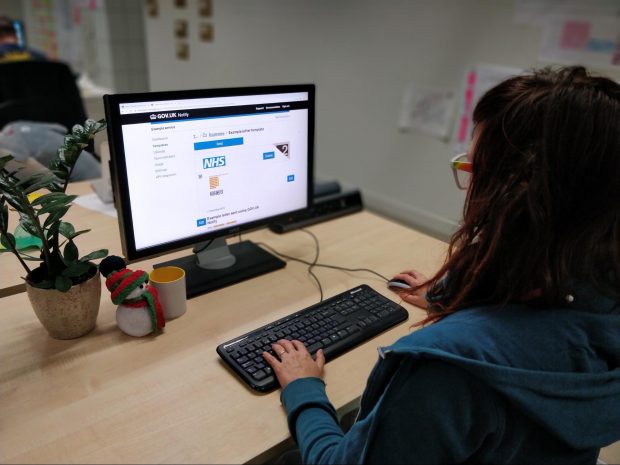Government Digital Service (GDS)
|
|
GOV.UK Notify is sending messages for more than 1,500 services across the public sector
Blog posted by: Peter Herlihy - Lead product manager, 20 December 2019 – Categories: GOV.UK Notify.

The Government Digital Service (GDS) collaborates across the public sector to help organisations meet their users’ needs. GOV.UK Notify is one example of how GDS does this. It lets service teams send text messages, emails and letters to their users cheaply and easily, improving the user experience.
Since its launch 4 years ago, use of GOV.UK Notify has grown exponentially. Today, nearly 500 organisations use it in more than 1,500 public services. In total, that's over 400 million updates, alerts, receipts and reminders sent a year. It is on track to save taxpayers an average of £35 million a year over the next 5 years.
Organisations that use GOV.UK Notify range from government departments to county councils, NHS trusts to GP surgeries, and fire services to ambulance trusts. It is used in a huge variety of ways, including to alert people to flood warnings, remind soldiers of their medical appointments, update people on their passport applications or inform prison wardens of their rotas.
We’re now seeing massive take-up right across the public sector. And, we want to keep it growing.
In this blog post, we’ll look at how GOV.UK Notify is helping the public sector transform, how its use has grown, and how you can start using it in your organisation.
From central government to local government
In 2015, GDS set up its Government as a Platform (GaaP) programme to tackle shared obstacles across government. One of these challenges was communicating with users. So, GDS – working closely with departments – created GOV.UK Notify to offer a trusted, secure, government-branded, reliable and affordable solution.
In May 2016, GOV.UK Notify sent its first message, and 9 months later it opened to all central government. In August 2017, after a 6-month pilot, it became available to local government.
Early adopters of GOV.UK Notify included the Driver and Vehicle Standards Agency who used it for MOT reminders, Environment Agency and Natural Resources Wales for flood warnings and Pembrokeshire County Council for 5 different services.
By using GOV.UK Notify, all these service teams could send their notifications cheaply and receive detailed performance reports. It also reduced time and hassle for both service teams and users.
More than half of all councils in the UK now use GOV.UK Notify. For councils, being able to send letters quickly is particularly helpful. Buckinghamshire County Council moved their school admissions correspondence to GOV.UK Notify and recently sent out more than 10,000 letters by simply uploading a spreadsheet. Moving from printing letters on the office printer to sending them through GOV.UK Notify – with just a few clicks – saved them a vast amount of time and money.
GOV.UK Notify in healthcare
The health sector started using GOV.UK Notify in early 2018. Early adopters included NHS Blood and Transplant, who you can see in the video below:
Over the past 6 months, we’ve seen a big surge in the use of GOV.UK Notify within the NHS. We now have over 20 NHS trusts and 100 GP surgeries sending messages for 140 different services. These services include NHS England’s Diabetic Eye Screening Programme for appointment correspondence and Guy’s and St Thomas’ NHS Foundation Trust’s remote monitoring to check in with patients after they leave their care.
Nearly all the GP surgeries in the London boroughs of Barnet, Camden, Enfield, Haringey and Islington use it for appointment reminders and to help people join up their electronic health patient records with their care records. Between them, these surgeries in the North Central London Clinical Commissioning Groups (NCL CCG) have sent nearly 500,000 text messages. Lisa Savage, Deployment Manager at NCL CCG, described how she worked with the team at GDS and helped reduce costs:
To date, we have used the GOV.UK Notify text messaging service on behalf of nearly 100 GP practices in NCL CCG. The service is simple to set up, and while there is a 1-working-day turnaround time, we have regularly found that the GOV.UK Notify team are far quicker to activate the service. At times, the Notify team have acted on our requests within minutes, and when queries have arisen, they have responded promptly.
In addition to the excellent customer service element, the allowance of 25,000 free text messages for each of our GP practices has supported us with the cost-efficient delivery of our project by minimising the need for postage.
GDS continues to collaborate closely with NHS Digital and NHSX, as usage of GOV.UK Notify grows. This helps us understand the specific needs of the health sector and make sure GOV.UK Notify meets them now – and in the future.
GOV.UK Notify in the wider public sector
Outside of central and local government and the NHS, other parts of the public sector also use GOV.UK Notify.
The emergency services, including police, fire and rescue teams, and ambulance trusts, use GOV.UK Notify to send a variety of messages. These include command room communications during major incidents and calling up volunteer firefighters.
GOV.UK Notify is also found in prisons to let prison wardens know their shift timings and locations in advance.
The tool also helps keep the armed forces healthy. Barracks use GOV.UK Notify to keep armed services personnel updated about their healthcare and dental appointments.
Get involved
We want to keep helping the public sector transform its services. We also want to continue to work closely with service teams to make sure GOV.UK Notify remains as useful and helpful as possible. GOV.UK Notify is easy to set up and use, and is almost completely self-service.
Find out more about using GOV.UK Notify and create a trial account.
Making GOV.UK more than a website
Original article link: https://gds.blog.gov.uk/2019/12/20/gov-uk-notify-is-sending-messages-for-more-than-1500-services-across-the-public-sector/
.gif)

